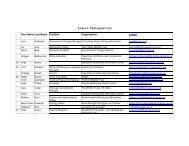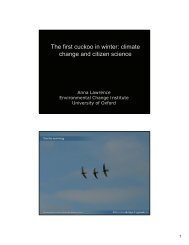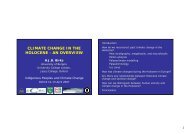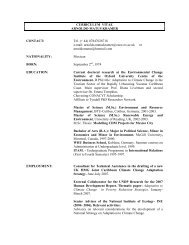ECI Annual Review 2006/2007 - Environmental Change Institute ...
ECI Annual Review 2006/2007 - Environmental Change Institute ...
ECI Annual Review 2006/2007 - Environmental Change Institute ...
Create successful ePaper yourself
Turn your PDF publications into a flip-book with our unique Google optimized e-Paper software.
6<br />
LAnd Degradation<br />
The year <strong>2007</strong> saw the long-awaited publication of Soil Erosion in Europe (eds<br />
Boardman and Poesen). This is the first state-of-the-art review of erosion in<br />
34 European countries plus consideration of many practical and policy related<br />
issues. The 58 chapter book resulted from a four year EU funded COST Action<br />
involving 21 countries chaired by John Boardman.<br />
John’s own work on erosion in Britain continues, especially in wet autumns<br />
such as <strong>2006</strong>. The focus recently has been on serious erosion in the Midhurst<br />
area of West Sussex, where soil from eroding potato and maize fields reaches<br />
the River Rother. This is a valuable trout stream and sediment impacts on<br />
the gravel bed to inhibit breeding. Such ‘off-farm’ effects of erosion are now<br />
accepted in Europe as of major societal concern. Complex relationships<br />
between land owner, tenant farmer, highway authorities, fisheries interests,<br />
local conservation schemes and the regulatory authority for rivers (the<br />
Environment Agency) are being explored.<br />
The idea of ‘desertification’ has been<br />
widely applied to recent landscape<br />
change in South Africa. Alarmist<br />
fears of creeping desertification have<br />
been expressed. Most researchers<br />
have concentrated on vegetation,<br />
identifying a change from mixed grass<br />
and shrub to predominantly shrub<br />
in the semi-arid Karoo. For farmers,<br />
the implication is a loss of palatable<br />
grazing.<br />
The <strong>ECI</strong> is gaining new insights into<br />
land degradation by studying changes<br />
in specific landscape signatures -<br />
badlands and deep gully systems. We<br />
are collaborating with the University<br />
of Cape Town and Rhodes University<br />
in South Africa and the Universities of<br />
Coventry and Leicester in the UK.<br />
The Karoo<br />
Erosion in the Karoo is typified by<br />
heavily eroded ‘badland’ areas and<br />
deep gully systems. For the past 10<br />
years we have concentrated on an<br />
area of the Klein Seekoei valley in<br />
the Sneeuberg uplands about 70 km<br />
north of the town of Graff Reinet. The<br />
valley is wetter than the lowland Karoo<br />
because of its altitude (ca. 1600 m)<br />
and is an area of sheep farming. In<br />
the past, the valley bottoms (‘lands’)<br />
were used to grow wheat.<br />
There is some evidence in the<br />
Karoo as a whole, and in the Klein<br />
Seekoei valley, that very high stock<br />
numbers (sheep largely) are the<br />
cause of vegetation change and soil<br />
erosion leading to the formation of<br />
badlands and gully systems. We are<br />
investigating:<br />
• the initiation of badlands and<br />
gullies;<br />
• the physical processes associated<br />
with formation and development of<br />
badlands and gullies;<br />
• changes in the degraded areas<br />
through time;<br />
• the knowledge and attitudes of the<br />
farming community;<br />
• the possibilities for rehabilitation<br />
of degraded areas;<br />
• the impact of erosion on<br />
hydrology, particularly dams and<br />
water quality;<br />
• rainfall patterns and climate<br />
change;<br />
• dam sedimentation and changing<br />
patterns of pollen, Cs-137 and<br />
Pb-210 ;<br />
• the fire history of the area.<br />
Methods<br />
The topic requires an interdisciplinary<br />
approach using methodologies from<br />
natural and social science, including:<br />
• monitoring of selected sites for<br />
change;<br />
• mapping of degraded areas using<br />
air photographs from 1945, 1980<br />
and 2000;<br />
• simulated rainfall experiments;<br />
•<br />
•<br />
•<br />
•<br />
Leader:<br />
Dr John Boardman<br />
Land Degradation in the Karoo, South Africa<br />
assembly of database on small<br />
dams;<br />
dating of sediment infill in small<br />
dams (NERC funded project);<br />
interviewing of farmers;<br />
coring of willows.<br />
Findings<br />
The interaction of management,<br />
especially severe overgrazing in<br />
the past, and wet/dry periods (with<br />
limited evidence of climate change)<br />
seems to explain present degraded<br />
landscapes.<br />
Key Publications<br />
Boardman, J., <strong>2006</strong>. Soil erosion<br />
science: reflections on the<br />
limitations of current approaches.<br />
Catena 68: 78-86.<br />
Boardman, J. and Poesen,<br />
J., <strong>2006</strong>. Soil erosion across<br />
Europe: major processes<br />
causes and consequences. In:<br />
J. Boardman and J. Poesen.<br />
(Editors), Soil Erosion in Europe.<br />
Wiley, Chichester. 479-487 pp.<br />
Keay-Bright, J. and Boardman,<br />
J., <strong>2006</strong>. <strong>Change</strong>s in the distribution<br />
of degraded land over<br />
time in central Karoo, South<br />
Africa. Catena, 67: 1-14.






